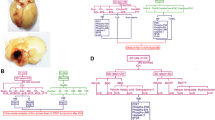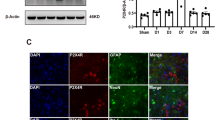Abstract
Intracerebral hemorrhage (ICH) leads to widespread pathological lesions in the brain, especially impacting neuronal survival and axonal regeneration. This study aimed to elucidate whether the Nogo-A (a myelin-related protein)/paired immunoglobulin-like receptor B (Pir-B)/tropomyosin receptor kinase B (TrkB) pathway could exert a regulatory effect in ICH. An ICH model was first established in Sprague Dawley rats, followed by different administrations of vehicle, k252a, or NSC 87877. The Morris water maze test was performed to observe ICH-induced cognitive dysfunction in rats. Rats in the ICH + NSC 87877 group showed better cognitive performance compared with those injected with vehicle or k252a. Neurobehavioral scores were identical. By harvesting brain tissues at different time points after ICH, we detected the expression levels of Nogo-A and PirB with western blot and immunofluorescence and found that they were markedly upregulated at 48 h after ICH. TUNEL and Fluoro-Jade B staining showed that NSC 87877 treatment attenuated ICH-induced apoptosis and neuronal death, whereas k252a treatment aggravated these pathological changes. The expression levels of growth-associated protein 43 (GAP43) and neurofilament 200 (NF200) were higher in the ICH + NSC 87877 group compared with the ICH + vehicle group, but were lower in the ICH + k252a group. Finally, we confirmed the protective role of p-TrkB/TrkB in ICH by western blot. To sum up, our study identified the inhibitory role of the Nogo-A/PirB/TrkB pathway in ICH; however, p-TrkB/TrkB may serve as a potential target for secondary brain injury post-ICH.






Similar content being viewed by others
References
Akbik F, Cafferty WB, Strittmatter SM (2012) Myelin associated inhibitors: a link between injury-induced and experience-dependent plasticity. Exp Neurol 235:43–52. https://doi.org/10.1016/j.expneurol.2011.06.006
Allen JK et al (2018) Sustained Adrenergic Signaling Promotes Intratumoral Innervation through BDNF. Induction 78:3233–3242. https://doi.org/10.1158/0008-5472.can-16-1701
Banerjee A, Paluh JL, Mukherjee A, Kumar KG, Ghosh A, Naskar MK (2018) Modeling the neuron as a nanocommunication system to identify spatiotemporal molecular events in neurodegenerative disease. Int J Nanomedicine 13:3105–3128. https://doi.org/10.2147/ijn.s152664
Ehrman LA et al (2014) The protein tyrosine phosphatase Shp2 is required for the generation of oligodendrocyte progenitor cells and myelination in the mouse telencephalon. J Neurosci 34:3767–3778. https://doi.org/10.1523/jneurosci.3515-13.2014
Eyal G et al (2018) Human cortical pyramidal neurons: from spines to spikes via models. Front Cell Neurosci 12:181. https://doi.org/10.3389/fncel.2018.00181
Fang MS et al (2017) Omega-3PUFAs prevent MK-801-induced cognitive impairment in schizophrenic rats via the CREB/BDNF/TrkB pathway Journal of Huazhong University of Science and Technology Medical sciences = Hua zhong ke ji da xue xue bao Yi xue Ying De wen ban. Huazhong keji daxue xuebao Yixue Yingdewen ban 37:491–495. https://doi.org/10.1007/s11596-017-1762-4
Fujita Y, Endo S, Takai T, Yamashita T (2011) Myelin suppresses axon regeneration by PIR-B/SHP-mediated inhibition of Trk activity. EMBO J 30:1389–1401. https://doi.org/10.1038/emboj.2011.55
Hijioka M et al (2017) Inhibition of leukotriene B4 action mitigates intracerebral hemorrhage-associated pathological events in mice. J Pharmacol Exp Ther 360:399–408. https://doi.org/10.1124/jpet.116.238824
Jeong SR et al (2012) Hepatocyte growth factor reduces astrocytic scar formation and promotes axonal growth beyond glial scars after spinal cord injury. Exp Neurol 233:312–322. https://doi.org/10.1016/j.expneurol.2011.10.021
Karuppagounder SS et al (2016) Therapeutic targeting of oxygen-sensing prolyl hydroxylases abrogates ATF4-dependent neuronal death and improves outcomes after brain hemorrhage in several rodent models. Sci Transl Med 8:328ra329. https://doi.org/10.1126/scitranslmed.aac6008
Lan X, Han X, Li Q, Yang QW, Wang J (2017) Modulators of microglial activation and polarization after intracerebral haemorrhage. Nat Rev Neurol 13:420–433. https://doi.org/10.1038/nrneurol.2017.69
Lei C, Wu B, Liu M, Tan G, Zeng Q (2016) Pathogenesis and subtype of intracerebral hemorrhage (ICH) and ICH score determines prognosis. Curr Neurovasc Res 13:244–248
Li N, Liu GT (2010) The novel squamosamide derivative FLZ enhances BDNF/TrkB/CREB signaling and inhibits neuronal apoptosis in APP/PS1 mice. Acta Pharmacol Sin 31:265–272. https://doi.org/10.1038/aps.2010.3
Li H et al (2018) Critical role for Annexin A7 in secondary brain injury mediated by its phosphorylation after experimental intracerebral hemorrhage in rats. Neurobiol Dis 110:82–92. https://doi.org/10.1016/j.nbd.2017.11.012
Meldolesi J (2018) Neurotrophin Trk receptors: new targets for cancer therapy. Rev Physiol Biochem Pharmacol 174:67–79. https://doi.org/10.1007/112_2017_6
National Research Council (2011) Guide for the care and use of laboratory animals, 8th edn. National Academies Press, Washington, DC
Naylor RL et al (2002) A discrete domain of the human TrkB receptor defines the binding sites for BDNF and NT-4. Biochem Biophys Res Commun 291:501–507. https://doi.org/10.1006/bbrc.2002.6468
Osborne A et al (2018) Neuroprotection of retinal ganglion cells by a novel gene therapy construct that achieves sustained enhancement of brain-derived neurotrophic factor/tropomyosin-related kinase receptor-B signaling. Cell Death Dis 9:1007. https://doi.org/10.1038/s41419-018-1041-8
Shen H et al (2015) Role of neurexin-1beta and neuroligin-1 in cognitive dysfunction after subarachnoid hemorrhage in rats. Stroke 46:2607–2615. https://doi.org/10.1161/STROKEAHA.115.009729
Song M et al (2015) Slitrk5 mediates BDNF-dependent TrkB receptor trafficking and signaling. Dev Cell 33:690–702. https://doi.org/10.1016/j.devcel.2015.04.009
Syken J, Grandpre T, Kanold PO, Shatz CJ (2006) PirB restricts ocular-dominance plasticity in visual cortex science (New York, NY) 313:1795–1800 https://doi.org/10.1126/science.1128232
Tan C, Yu C, Song Z, Zou H, Xu X, Liu J (2017) Expression of microRNA-29a regulated by Yes-associated protein modulates the neurite outgrowth in N2a cells 2017:5251236 10.1155/2017/5251236
Tsai SY et al (2007) Intrathecal treatment with anti-Nogo-A antibody improves functional recovery in adult rats after stroke. Exp Brain Res 182:261–266. https://doi.org/10.1007/s00221-007-1067-0
Urday S et al (2015) Targeting secondary injury in intracerebral haemorrhage--perihaematomal oedema. Nat Rev Neurol 11:111–122. https://doi.org/10.1038/nrneurol.2014.264
Wang F et al (2007) Nogo-A is involved in secondary axonal degeneration of thalamus in hypertensive rats with focal cortical infarction. Neurosci Lett 417:255–260. https://doi.org/10.1016/j.neulet.2007.02.080
Wang Z, Wu L, You W, Ji C, Chen G (2013) Melatonin alleviates secondary brain damage and neurobehavioral dysfunction after experimental subarachnoid hemorrhage: possible involvement of TLR4-mediated inflammatory pathway. J Pineal Res 55:399–408. https://doi.org/10.1111/jpi.12087
Wang Z et al (2017) Identification of two phosphorylation sites essential for annexin A1 in blood-brain barrier protection after experimental intracerebral hemorrhage in rats. J Cereb Blood Flow Metab : Off J Int Soc Cereb Blood Flow Metab 37:2509–2525. https://doi.org/10.1177/0271678X16669513
Wilson TJ (2018) Novel uses of nerve transfers neurotherapeutics. J Am Soc Exp NeuroTherapeutics. https://doi.org/10.1007/s13311-018-0664-x
Xi G, Strahle J, Hua Y, Keep RF (2014) Progress in translational research on intracerebral hemorrhage: is there an end in sight? Prog Neurobiol 115:45–63. https://doi.org/10.1016/j.pneurobio.2013.09.007
Yiu G, He Z (2006) Glial inhibition of CNS axon regeneration. Nat Rev Neurosci 7:617–627. https://doi.org/10.1038/nrn1956
Zhang JC et al (2014) Antidepressant effects of TrkB ligands on depression-like behavior and dendritic changes in mice after inflammation. Int J Neuropsychopharmacol 18. https://doi.org/10.1093/ijnp/pyu077
Zhou Y, Wang S, Li Y, Yu S, Zhao Y (2017) SIRT1/PGC-1alpha signaling promotes mitochondrial functional recovery and reduces apoptosis after intracerebral hemorrhage in rats. Front Mol Neurosci 10:443. https://doi.org/10.3389/fnmol.2017.00443
Zhu W et al (2018) Changes in motor function, cognition, and emotion-related behavior after right hemispheric intracerebral hemorrhage in various brain regions of mouse. Brain Behav Immun 69:568–581. https://doi.org/10.1016/j.bbi.2018.02.004
Funding
This work was supported by the Project of Jiangsu Provincial Medical Innovation Team (No. CXTDA2017003), Suzhou Key Medical Centre (No. Szzx201501), Scientific Department of Jiangsu Province (No. BE2017656), Suzhou Government (No. LCZX201601), Youth Science Foundation of Suzhou China (No. KJXW2017038), Science and Technology - Basic Research Project of Medical and Health Application of Suzhou China (No. SYS2018089), and the National Key R&D Program of China (No. 2018YFC1312600 & No. 2018YFC1312601).
Author information
Authors and Affiliations
Contributions
J.W and X.F conceived and designed the study. Y.L and C.M performed the experiments and wrote the paper. H.L and H.S helped conduct the literature review. X.L and G.C reviewed and edited the manuscript. Yinlong Liu and Chao Ma contributed equally to this work. All authors read and approved the manuscript.
Corresponding authors
Ethics declarations
All procedures were approved by the Animal Protection Committee of Soochow University and were performed in accordance with the National Institutes of Health’s guidelines on the care and use of animals and the Animal Research: Reporting In Vivo Experiments guidelines. All efforts were made to minimize animal suffering and the number of animals used.
Conflict of Interest
The authors declare that they have no conflict of interest.
Additional information
Publisher’s Note
Springer Nature remains neutral with regard to jurisdictional claims in published maps and institutional affiliations.
Rights and permissions
About this article
Cite this article
Liu, Y., Ma, C., Li, H. et al. Nogo-A/Pir-B/TrkB Signaling Pathway Activation Inhibits Neuronal Survival and Axonal Regeneration After Experimental Intracerebral Hemorrhage in Rats. J Mol Neurosci 69, 360–370 (2019). https://doi.org/10.1007/s12031-019-01365-1
Received:
Accepted:
Published:
Issue Date:
DOI: https://doi.org/10.1007/s12031-019-01365-1




